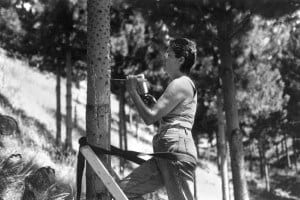EIT’s ideaschool is revisiting a creative initiative inspired by a sense of place as part of the institute’s 40th anniversary celebrations.
An exhibition running from 1-11 November in ideaschool’s Vent Gallery looks back on the Pinus Radiarta Sculpture Symposium held in 1993 which brought together international, national and local artists to create works on the Hawke’s Bay campus.
At the time, the Ōtātara Art Centre – the forerunner of EIT’s ideaschool – was located on a hillside behind the institute campus. The pine plantation that surrounded the centre inspired the symposium’s theme.
Curating the exhibition, ideaschool lecturer Linda Bruce says the event generated a tremendous dynamic, integrating creative practice with public interaction.
“It was a wonderful creative and cultural experience, with a mixture of people and work.”
Twenty-four artists took part and out-of-towners were housed at EIT’s School for Māori Studies, Te Manga Māori (now Te Ūranga Waka), for eight days while they crafted their works in pine.
The symposium was funded by Hawke’s Bay Polytechnic (now EIT) and Creative New Zealand, which stipulated a diversity of participants.
Internationally recognised artists included John McQueen, whose work is exhibited in the Smithsonian National Museum of American Art, and locally-based designer David Trubridge, who initiated the original concept for the symposium.
The event attracted established creative practitioners such as furniture designers Carin Wilson, Humphrey Ikin and Peter Maclean, sculptors Ricks Terstappen and Jeff Thomson, Antarctic Arts Fellow Virginia King, stone and metals artist Louise Purvis, Māori arts academics Bob Jahnke and Fred Graham, ceramicist Brownynne Cornish and Ōtātara Arts Centre head Jacob Scott.
Carter Holt Harvey supplied logs and Stihl “a row of shiny new chainsaws” and the local community also backed the event with generous sponsorship.
Undertaking a research project on the symposium, Linda contacted the artists who took part and has included their reflections in the exhibition.
Bronwynne Cornish says her creation “Eve”, formed from earth and covered in a slip used in crafting ceramics, acknowledged the environment. A spectacular final stage of the artistic process was reminiscent of pagan rituals, with logs piled on the work set alight to vitrify the clay.
John McQueen’s partner, Margo Mensing carved a poetic message into tree trunks. “Marks made here,” it read, “are no more than scars on these upstart upstanding trees – as brief as grass.”
John Bevan Scott, one of New Zealand’s best known Māori artists and the only participant to have died since the symposium was held, crafted kaitiaki, shadow-like forms that were inspired by the scars on tree trunks. One of these works is included in the exhibition.
After the symposium, the works remained on campus for three months as a sculpture park. They then became the property of the artists.
Linda has discovered some of the pine works were subsequently tanalised to ensure their preservation.
EIT is holding an Open Day from 11am-2pm on Sunday, 1 November, when visitors to the exhibition will also be able to wander through ideaschool’s art studios and meet students and teaching staff.

